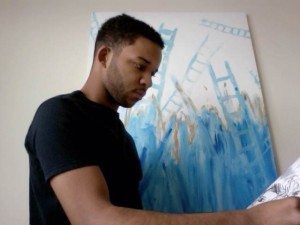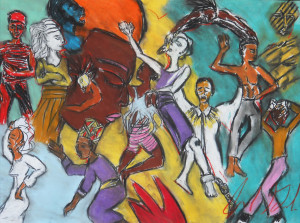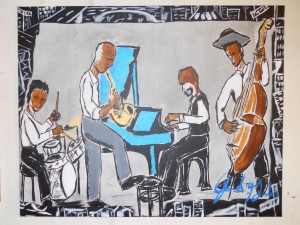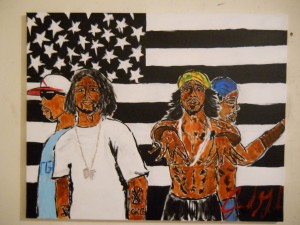At 27, Josiah Golson has already achieved much. A graduate of the University of Tennessee-Chattanooga and the University of Texas-Austin law school, he recently began practicing real estate law in Chattanooga. He is also an artist, and is involved with several arts groups.
See more of Josiah’s art at: Josiah Golson
For interviews with other painters see: Ellyn Bivin / David Jones / James Mckissic / Renel Plouffe / James Tucker / Larry Young
How did you become interested in art?
My mother is a trained artist, and in fact an art teacher. She was an early inspiration for me. When I was six years old, I remember making drawings that I imagined being in motion. Even then I was trying to tell a story with pictures. I made little comic books and so on. I’ve drawn all my life, but I wasn’t serious about sharing my art until my second year of law school. I was dealing with some issues around whether I wanted to continue in that field. I’ve always had an interest in the arts, from drawing to film making, and as a diversion I began to draw pictures in the style of a film strip, what I call ‘frames’. I began to create story lines and to illustrate them.
So your approach to drawing evolved as an emotional experience based on a love for a variety of visual media?
Yes, I think it was an attempt to connect with my youth and with things that inspired me.
Can you describe your approach to making your drawings and how you arrived at it?
I didn’t have any real formal training, such as working from a live model. My drawings come from my imagination. I see the image as if it was in a movie, and then I draw it straight from that. A big influence on my work is cinema and the process of cinema, particularly the making of story boards. I like story boards because you know there is a story being told, but there is not a need for perfection. That allows me to just go with the flow of the ideas that I’m getting. It gives me the freedom to draw in a way that’s quick enough so I don’t lose momentum. Usually I’m moving at a pace that allows me to get the image down while it’s fresh and vital. I don’t want to start over-thinking it or muddling about. I could lose the inspiration that caused me to choose the visual idea in the first place. I’m seeking a rhythm, almost a musical quality in my drawing.
You certainly have a very ‘live’ line in your work. To what extent do you pre-plan these strips of related drawings?
I do most of my planning in my head, waiting until I get to the point where I can see where I want to take a piece. To the extent that I do that sort of planning, it’s usually only for two or three images at a time. For instance, one of the pictures I have in the Graffiti show is called “The Fall of Rock”. It centers on the punk rock scene. For that drawing I tried to think of images that were not stereotypical but have a powerful element to them. Sometimes I draw a quick sketch on a separate piece of paper but most often I work directly by placing key images on the paper and then working in other images that complement them.
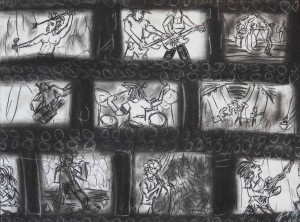
The Fall of Rock 18×24 Conte Crayon on paper
Let me walk back through what you’ve just said. You have a basic structure in your head when you start out, but the exact nature of an individual image is left to the moment as you work.
Yes. That’s right.
Your two black and white drawings, “The Fall of Rock” and “Crossroads Chronicles” are done in an obvious ‘film strip’ style. However, “The Living Flag”, another of your drawings, is clearly telling a story but not in a sequential way.
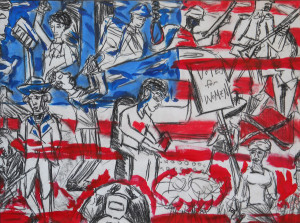
The Living Flag 18×24 Pastel on paper
I’ve actually done several “Living Flag” pictures. In those pieces my goal was to present the American experience, the spirit of America if you will, as it is represented in the meaning of the flag—the ideas of freedom, justice, equality, and the sacrifices that people have made for those things. I could have put them in a scene by scene format but those facets of our lives are so intertwined with the idea of America and with each other, so emotionally connected, or in some cases opposed, I decided to have them collide, as it were, on the flag itself. I tried to relate the individual elements to the colors of the flag, which I felt intensified the visual experience.
You have a fourth drawing you’re showing, “Reunion”, that takes yet another approach and doesn’t, at least to my eye, seem to tell a story at all.
Yes, in that one and in some other of my work there’s not a clear narrative. It’s just a scene. It doesn’t have a specific story. It’s pure action. That’s what motivates the piece.
I chose the title “Reunion” because I felt as I was drawing the different characters and individuals there is a sense of unity present. However, at the same time, there is sense of diversity and difference. So I think there are linkages, but at no time was I going for a narrative that you’d find in the other pieces we’ve been talking about.
At 27 you’re at the beginning of your career in art, but do you have a sense of how your work might be evolving?
I do. Well, a little bit, anyway. I know I want to move forward with the narrative style. I think that’s where I’m strongest. I’d like to see how far I can take it. In our society we rely on cinema a way to process experience. It’s become so much a part of our culture, it’s now all pervasive. Even though people don’t go to galleries and museums as much as they see film and TV, I think that can work in favor of the plastic and visual arts. The imagery of the cinema can be utilized to enhance visual art. I’d like to tell more complete stories, though not to the point of graphic novels, we already have those, but I’m moving toward doing more complete stories that may not be as explicit as a graphic novel, but will have a compressed richness to them.
What artists have influenced you?
I have people I feel have influenced how I think about art, but not all of them are artists.
So tell me about them.
Well, music certainly has a huge impact on me and is a very important part of my life. Among musicians, I’d have to say that one of my biggest influences is Bruce Springsteen—his whole narrative of struggle in life, his themes around the American landscape and the endless unfolding of American self-discovery. His way of making beauty out of life–the little things in life–are an inspiration to me.
There’s also a film maker, Julian Schnabel. I found him when I saw a movie on Jean Michel Basquiat, who is a painter I like. Schnabel’s film, “The Diving Bell and the Butterfuly”, feels like a painting. I mean as a film it’s made in a painterly way. It’s not using all the traditional cinematic techniques, but idiosyncratically tells its story in a powerful way. I love the way he juxtaposes images—old film, old pictures, old iconography—and mixes everyday things and lush European landscapes. In a sense, he made a painting out of a movie, which has inspired me to make movies out of drawings.
As for artists, two come immediately to mind. The drawings of Picasso had a big impact on me. Despite his being on a pedestal as THE 20th century artist, I love the drama and freedom in his work. The way he transformed life into image, even something as horrible as “Guernica”, helped to free me up to draw stories as I evolve them in my mind. Seeing his work allowed me a freedom I doubt I could have found in a more classical approach to drawing. The other artist is Matisse, because of how he combined a linear approach with color. I love his color. Sometimes I find the more color I use in my own work, the less linear it becomes. I love exploring how color impacts my basic approach.
Beside your drawings, are you working in other media?
Yes, I am. Currently my favorite media, as you might guess, are conte crayon and pastel, but I’m also working with acrylic paints. They’re not as natural for me as pastel, but the work is coming along. I still feel more comfortable with the drawings but I’d like to develop as a painter because I think there is more I can do with that. I can push my art further.
Return to Interviews with Artists
